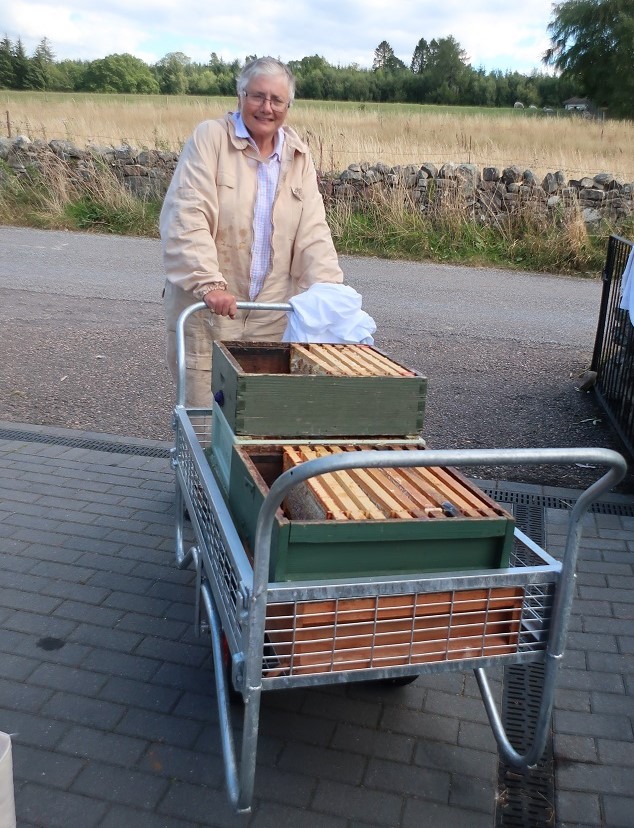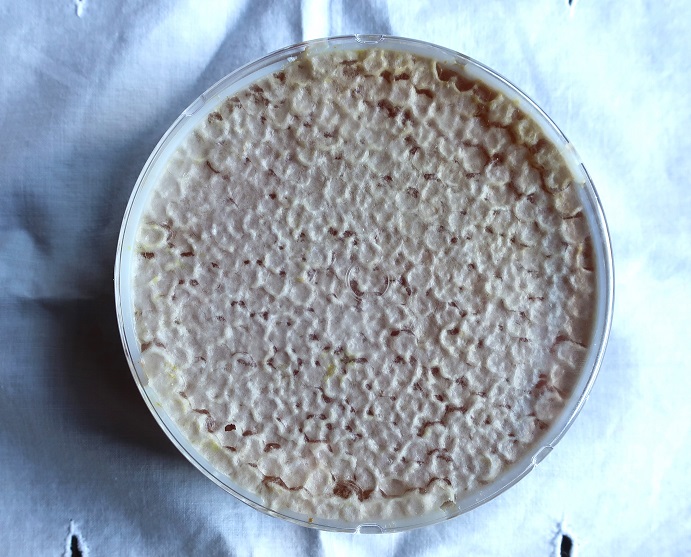
Does it matter where you place the next shallow super during a nectar flow? Above the first one or below the first one? I was told that I should place it below the first super when I started beekeeping. That was such a long time ago and I’ve forgotten the reason, if there was one. Placed above the brood nest and queen excluder might be a warmer position for the wax makers. However, if you were not using a queen excluder the queen might move up upwards to lay. She would be less likely to do that if there was a nearly full super of honey above the brood box and acting as a barrier. That’s how I got 21 perfect Ross rounds produced in August this year. I took away the queen excluder and put the super of winter honey stores above the brood box. The colony was incredibly strong as a result of the Demaree method of swarm control and a double queen system till the end of July.

Travel Staining?
Placing supers on top of those currently being filled increases the distance from the hive entrance to the new super for heavily laden foragers. There will be more traffic over the capped comb below which might stain and darken the wax. How much does this matter?
A couple of times this season, new beekeepers have asked me where they should place the second super. I don’t think it is important for the super to be in one position or the other, but I did a bit of research to see what other beekeepers recommend in their textbooks.
What do the Books Say?
Clive de Bruyn1 advises that both placing supers on top of the first one, or underneath the first one are correct. “When placing the second super on the hive it can be placed on top of the first or underneath it, directly on the queen excluder. Depending on the circumstances, both options can arguably be correct. It is easier and simpler to add the extra super on top. If the flow is coming to an end and the nights are cool then this is the best option. If the colony is crowded and the flow looks likely to continue then more honey can be collected by placing the empty super under the partially full one.”
Robert Couston2 former Specialist Beekeeping Adviser at The Scottish Colleges of Agriculture, tells us, “A super is best placed on top of a previous one, especially if foundation has to be drawn, and should be added when the previous super is approximately two-thirds full.”
A Better Honey Crop?
Do we get a better honey crop if supers are above or below? This question has been the driver for at least two conclusive and concurring research projects. Jennifer Berry and Keith Delaplane3 experimented over two seasons and two nectar flows in Georgia USA. They set up three apiaries with ten colonies in each. At the start of the nectar flow the colonies were equalised so that they all had the same amount of brood, adult bees, and stores. Each colony within each apiary was randomly assigned to one of two treatment groups.
Top and Bottom-Supering.
Treatment one was called top-supering where empty honey supers were placed (as they were needed) on top of honey supers already on the hive. Treatment two was called bottom-supering, and the next super was placed below the one already in place above the queen excluder. The hive configurations were uniform and consisted of a deep brood hive body with a shallow box of honey as food stores above this. A queen excluder was placed above these two boxes and between the honey supers in the experiment.
During the experiments, supers were added as they were considered necessary according to the nectar flow. When supers were needed, one super was given to every colony on the same day. The available comb was equalised so that each colony had the same amount of empty comb. Any weak colony was removed from the study. Interestingly, volatiles in empty comb are known to affect hoarding behaviour in honey bees and stimulate them to store honey.
The Results.
At the end of each nectar flow, supers were removed and weighed at once to estimate net gain of harvestable honey. So which method of supering was best? The researchers found that there was no significance difference between the net weight results of the two study groups. These results agreed with previous studies proving that there is no advantage to the labour-intensive bottom-supering over top-supering in terms of achieving a better honey crop.
I hope this helps you make your own decisions about supering and advising others.
References.
1de Bruyn, C. (1997) Practical Beekeeping, The Crowood Press Ltd
2Couston, R. (1990) Principles Of Practical Beekeeping, Northern Bee Books
3Berry, J.A. & K.S. Delaplane. (2000) Effects of top- versus bottom-supering on honey yield. American Bee Journal 140(5): 409-410

Thanks for this Ann. Ive often wondered if, with the goid weather we have had (Kent) Ivy may be our equivalent of the Goldenrod flow in the US , so having ensured mine all have a super full of stores Im supering an extra box with 6 frames and dummies to see if I can encourage them to keep busy.
Re ‘Interestingly, volatiles in empty comb are known to affect hoarding behaviour in honey bees and stimulate them to store honey.’
I wonder if you recall where this cones from?
BR
Frazer
Hello Frazer. That is a great idea to keep them busy drawing comb from ivy. I wish I had thought of that. Thanks for the tip as I will definitely try next season. It has been so warm here lately that it would have worked in the north. The volatiles in empty comb…. was quoted in the Delaplane and Berry research paper. Best wishes, Ann.